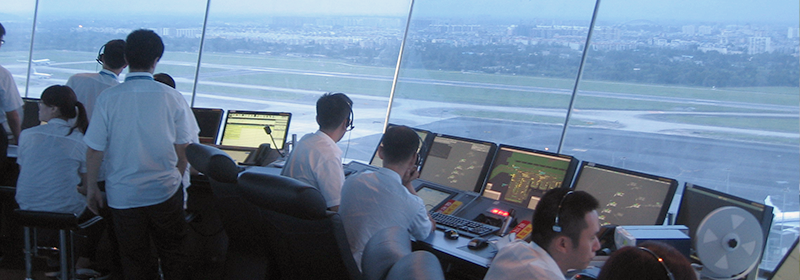- In 2020 the city will have a second international airport which will multiply the number of flights it receives. Indra Air Automation System has been chosen to manage what will be one of the most complex and congested airspaces in the country
- Indra is a leading company in the Chinese air traffic management market: it has modernized two of the main en route centers, deployed around 40 surveillance radars and installed more than 800 air navigation systems
- Is the only company in the world with a portfolio of proprietary air traffic solutions that can manage a flight door to door, from take-off right up until landing

The Chinese South West Air Traffic Management Bureau (SWATMB) has chosen Indra to implement some of the key systems that will help to turn the city of Chengdu into the country's third airport hub. It has awarded Indra contracts worth around 27 million euros this year.
Chengdu is one of the pillars of China's economic activity and the gateway to whole of the west of the country. In recent years, the city's air traffic has continued to grow, taking the Chengdu-Shuangliu international airport close to its maximum capacity. Accordingly, there are plans to put a second international airport into service in 2020, Chengdu-Tianfu, with capacity to receive up to 100 million passengers a year.
To absorb the consequent huge increase in traffic, the SWATMB is building a new Terminal Area Control Center which will be equipped with Indra Air Automation system. The system will automatically generate the flight plans for all aircraft, centralize information and distribute it to users. It will be in charge of controlling one of the most congested spaces in China and the world.
At these airports, Indra will also be responsible for implementing the first fully-integrated control tower system which will enter into operation in the country. The solution will facilitate the flow of information between both airport towers and the different control centers (route and terminal maneuvering area) and data received from ground surveillance radars (surface and multilateration radars, precision approach radars, etc.) and other external information sources, such as the weather service. It will allow controllers to share a centralized and integrated image of the traffic situation.
The tower system will have EFS (Electronic Flight Strips), which will replace the paper strips on which controllers acknowledge the data and handle the flights for which they are responsible, and it will include a backup system and test and simulation equipment.
World leader in safe landing systems
In addition to automation systems, Indra will supply instrument landing systems (ILS) for the Chengdu Tianfu airport. This allows pilots to land safely on runways in adverse weather conditions.
This has been one of the biggest navigation aid system contracts awarded in China so far this year. Indra is the main provider of this technology in the country and one of the most important in the world. In China alone, Indra has implemented around 400 instrumental landing systems, four of them at Chengdu Shuangliu airport.
Indra's instrument landing system has made its name as the best navigation solution in the world. One of Indra's 10 ILS systems installed at Shanghai Pudong airport was approved in March 2018 for use in operations in any weather condition (category CATIII A). It was the first system based on ILS guidelines to achieve this category in the country.
Indra has also rolled out around 400 navigation aid systems (DVOR/DME) across China, helping aircraft to follow their air route as closely as possible.
A shared vision of traffic
In recent years Indra won one of the main contracts for implementing automation systems in Chengdu. Every center in the region benefits from perfect interoperability and maximum efficiency for its systems.
Since 2012, the en route center in Chengdu has used Indra's technology to manage the traffic of five regions in SouthWest China, more than 2.3 million kilometers squared in total. Xian is another major en route center which uses Indra's automation system, in this case to manage flights spanning the northwest of the country.
The company also supplied eight radars (MSSR) for the southwest region in 2013, forming part of the network of 40 radars that cover surveillance for 60% of Chinese airspace.
Indra in China
Indra has been operating in the Chinese market since 1989, setting up a subsidiary in Beijing. In the last 25 years, it has undertaken several projects in areas such as air traffic, simulation, security and urban transport and traffic. In addition to the ATM projects, Indra has supplied two Airbus 320, two Boeing 737 and two Airbus 330 simulators to Hainan Airlines Group, and has supplied a Eurocopter 225 (EC225) flight simulator to the Airbus Helicopter training center in Beijing. It has also helped to modernize the transport system in the major Chinese cities, completing a large number of tunnels and projects for highway control systems and equipment. It has also supplied urban traffic control systems, including underground and light rail and ticketing systems. The company has also developed the Hong Kong maritime control system.
About Indra
Indra is one of the leading global technology and consulting companies and the technological partner for core business operations of its customers world-wide. It is a world-leader in providing proprietary solutions in specific segments in Transport and Defence markets, and the leading firm in Digital Transformation Consultancy and Information Technologies in Spain and Latin America through its affiliate Minsait. Its business model is based on a comprehensive range of proprietary products, with a high-value focus and with a high innovation component. In the 2017 financial year, Indra achieved revenue of €3.011 billion, with 40,000 employees, a local presence in 46 countries and business operations in over 140 countries.